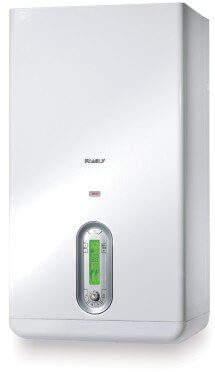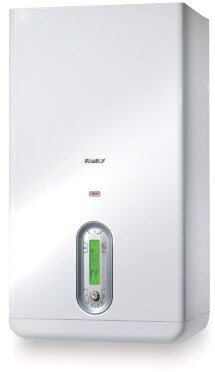Riello Family Condens 3.0 Kis LPG Condensing Boiler Complete With Smoke Kit - New Erp
Riello Family Condens 3.0 Kis LPG Condensing Boiler Complete With Smoke Kit - New Erp - Coaxial smoke kit is backordered and will ship as soon as it is back in stock.
Couldn't load pickup availability
Come funziona la spedizione
Come funziona la spedizione
I costi di spedizione variano a seconda del peso e della modalità di spedizione dell'ordine.
I nostri servizi di spedizione:
- Spedizione standard: consegna stimata dai 2 ai 5 giorni lavorativi
- Spedizione Premium: consegna garantita in 24 ore lavorative
- Spedizione Premium + Consegna al piano: consegna garantita in 24 ore lavorative
Consulta le tabelle per i prezzi della spedizione standard per l'Italia e per le Isole Minori e Zone Disagiate.
Per ulteriori dettagli sulla Spedizione Premium, consulta la pagina di spedizione premium.
Servizio clienti
Servizio clienti
Il nostro servizio di assistenza è dedicato a fornire supporto ai nostri clienti per qualsiasi problema o domanda che possano avere prima o dopo l’acquisto dei nostri prodotti.
Utilizza il canale di comunicazione diretta per parlare con un nostro operatore, oppure inviaci una mail ad uno degli indirizzi elencati nella pagina contattaci.
Il nostro team di assistenza clienti è composto da professionisti altamente qualificati e sempre pronti ad aiutare i clienti a risolvere qualsiasi problema o rispondere a qualsiasi domanda in modo rapido ed efficiente. Ci impegniamo a garantire la massima soddisfazione del cliente e a fornire un servizio di assistenza post-vendita di altissima qualità. Quindi, se hai bisogno di assistenza, non esitare a contattarci; saremo lieti di aiutarti in ogni modo possibile.
Description
Description
RIELLO FAMILY CONDENS 3.0 KIS LPG CONDENSING BOILER COMPLETE WITH FUME KIT - NEW ErP 2015 :
Family Condens a technologically advanced wall-hung boiler which best combines comfort, energy saving and respect for the environment.
- Product code: 20102936
- Class A heating energy efficiency
- Sanitary energy efficiency profile XL Class A
Characteristics of heating/DHW operation:
- Furnace thermal power (heating) min-max: 3.2÷25.0 kW
- Useful thermal power (sanitary) min-max: 3.2÷30.0 kW
- Energy efficiency (92/42/EEC) ****
- Useful efficiency at Pn* (50°C-30°C): 106.8%
- Profit return 30% (47th return): 109.9%
- Sealed chamber, forced draught
- Quantity of hot water with Δt 25°C: 17.2 l/min
- Minimum domestic water flow rate: 2 l/min
- Dimensions (hxwxd) mm 845 x 453 x 358 ; 43 kgs
- Electrical protection degree: IP X5D
- NOx class: 5
- Power supply: LPG
General characteristics
FAMILY CONDENS
- Yield ****
- Low polluting emissions
- Aluminum condenser, with premix burner
- Models for combined instantaneous and storage heating
- For indoor, outdoor and recessed installations
Family Condens is a wall-mounted boiler that combines comfort, energy saving and respect for the environment in the best possible way. The new primary heat exchanger completely made of aluminum with front access to the combustion chamber (models 2.5 and 3.0) guarantees better efficiency and duration. Family Condens is available with powers from 2.8 to 35 kW.
Characteristics:
- Modulation ratio 1:10 (minimum power 2.8 kW) which allows the boiler to respond to all heat requests
- Modulating circulator, low consumption (IEE≤0.20)
- 3 Stars in sanitary comfort according to EN 13203
- Remote alarm system that allows remote signaling of the boiler lockout status
- Special Family functions: Wellness button, Memory button, Touch&Go function, Intelligent system filling
- Assembly template, hydraulic fittings and power supply cable supplied
- LPG conversion kit (G31) supplied for 3.5 models
- Standard external probe.
ErP: Energy related Products
The new European regulations for heat generators
ErP is the acronym of “ Energy related Products ” (products connected to the use of energy) and is the abbreviation that identifies the European Directive ErP 2009/125/EC, defined by the EEC with the intention of reducing the energy consumption of products through eco-compatible design ("eco-design ").
The field of action of this European Directive is extremely broad as up to now it has involved products such as light bulbs, air conditioners, washing machines, fans, etc. Following the publication in September 2013 of a series of implementing regulations, starting from 26 September 2015 it will also apply to heating products and the production of domestic hot water.
From the same date, other regulations will also become effective which will implement the energy labeling of the same product families. The transitional period between the publication of the regulations and their activation throughout the territory of the European Community was necessary to allow the full implementation of the contents by companies and market players.

The energy labeling of products for heating and domestic hot water production
The regulations issued require that all products intended for heating and/or for the production of domestic hot water, with a nominal thermal power lower than or equal to 70 kW, are placed on the market with an energy label that highlights their efficiency class.
Note: the regulation provides for the mandatory presence of the energy label for the release of the product from the factories to the market. All products previously introduced, for example present in distribution warehouses, can be regularly marketed even if they do not have an energy label. Various energy labels have been provided based on the use of the generator used: for heating from A++ to G; for the production of domestic hot water from A to G.

 The purpose of energy labels is to allow the consumer to easily identify the level of efficiency of a product and to be able to make a homogeneous comparison between products that use different technologies. For products whose transformation efficiency is influenced by external conditions, such as heat pump products, as has been done for air conditioners, the efficiency figure is reported for the average climatic range.
The purpose of energy labels is to allow the consumer to easily identify the level of efficiency of a product and to be able to make a homogeneous comparison between products that use different technologies. For products whose transformation efficiency is influenced by external conditions, such as heat pump products, as has been done for air conditioners, the efficiency figure is reported for the average climatic range.
In addition to the product energy labels, the European regulations have also provided for the creation of a system label in the event that a plant is created in which various appliances, components and controls operate.
This labelling, thanks to the combinations of the data of the various elements used in the plant, will make it possible to create systems capable of reaching levels of efficiency even higher than those of the individual generators. The European regulation states that the system label must be made available by whoever supplies and/or puts the system into operation (sellers-installers); however, this option is also granted to manufacturers .
Product Guarantee
All products for sale on our site are new and packed. The guarantee on this article is 24 months from the date of purchase.
Scheda Tecnica
Scheda Tecnica
- peso: 50.0 kg
- classe energetica produzione acs: A
- classe energetica riscaldamento: A
- gas: LPG
- marca: Riello
- metri quadri : 220
- modello: CALD_339G
- potenza in kw: 30
- potenza nominale: 30
- superficie riscaldabile mq: 220




